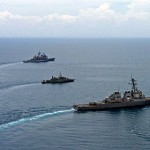At the 14th edition of the Shangri-la Dialogue held in Singapore from 29-31 May, China’s ongoing land reclamation activity in the South China Sea was the centre of attention. This reclamation indicates China’s increased assertiveness and unilateralism in international waters. Action of this nature defies the 2002 Declaration on the Conduct of Parties in the South China Sea signed by ASEAN states and China. The declaration calls for the resolution of “territorial and jurisdictional disputes by peaceful means” and encourages “self-restraint in the conduct of activities” to avoid any kind of escalation.
China’s tendency to change the existing status quo in the South China Sea, of which this is the most recent instance, raises concerns for all the actors in the Asia-Pacific region. These revisionist activities inevitably create a strategic imbalance by threatening the freedom of navigation and resource exploitation by other sovereign actors in the Asia-Pacific region.
India’s concerns on the rising Chinese foothold in the South China Sea is not an exception. Although India does not have a claim on the disputed sea, the growing tensions in the region hold significant ramifications for India. The South China Sea occupies an important place in India’s geopolitical cartography, and its maritime interests in the region are two-fold: first, its trade with the Association of Southeast Asian Nations (ASEAN) and East Asian countries (Japan and South Korea); and second, India’s procurement of energy supplies. Both factors play a strategic role in the country’s foreign policy.
Almost 92-95% of India’s total trade passes through the Indian Ocean, of which, about 55% passes through the Strait of Malacca. In an effort to meet its rising energy demands, India has diversified its energy supply chain, and as a result almost 70% of its oil imports are shipped. This goes some way in validating India’s interest in the South China Sea.
While not as active a player as China, the U.S. and ASEAN countries, in the South China Sea, India is involved in activities on the margins of the Sea that create clashes with Chinese interests. India’s public sector company ONGC Videsh is involved in oil and gas exploration in Vietnam’s offshore blocks, which are believed by China to be part of its Exclusive Economic Zone (EEZ). This has created a standoff between India and China, resulting in Beijing issuing a warning to New Delhi that “any oil and gas exploration work should get approval first from China”.
With its clear strategic interests in the South China Sea, India has increasingly become vocal and firm in its position vis-a-vis the resolution of disputes in the sea. India’s clearly articulated position is that it supports “freedom of navigation in the high seas” and ensures that “all countries in the region adhere to the international conventions on the law of the sea in this issue”. In accordance with the UNCLOS, South China Sea is a common sea lane of communication for all countries to use. So, any restriction does raise concerns for India.
Unsurprisingly, India’s position on international law runs contrary to Beijing’s interests, making the South China Sea yet another bone of contention between the two countries.
India’s diplomatic posture has remained firm on this issue. In 2013, at the 8th East Asia Summit, then Indian prime minister Manmohan Singh stated that “a stable maritime environment is essential to realise our collective regional aspirations”. The current South China Sea policy under Narendra Modi, is a continuation of the firm position taken by the previous government. At the 9th East Asia Summit in Myanmar in November 2014, Modi called for “efforts to conclude a Code of Conduct on South China Sea by a process of consensus”. A little over a month earlier, the India-US Joint Statement signed by Modi and President Barack Obama made special reference to the rising tensions in the South China Sea, as both India and the U.S. “affirmed the importance of safeguarding maritime security and ensuring freedom of navigation and over flight throughout the region, especially in the South China Sea”.
India and the U.S. went a step further during Obama’s January 2015 visit to India with the signing of the U.S.-India Joint Strategic Vision for the Asia-Pacific and Indian Ocean Region, reaffirming the positions of both countries. A stable South China Sea is a major part of Modi’s “Act East Policy” in which India is coordinating with the countries in the region, and in doing so, posing a counter-challenge to China’s increasing footprint in India’s strategic backyard—the Indian Ocean.
Given India’s economic and security objectives in the South China Sea, it too will have to act proactively to safeguard its own interests. This will require India to facilitate greater diplomatic and security ties with littoral Southeast Asian states like Vietnam, Singapore, Indonesia and the Philippines. Apart from this, India also needs to strengthen its strategic and defence ties with the U.S., Japan and Australia in order to balance the increasing assertiveness of China in the Asia-Pacific region.
Amrita Jash is Editor-in-chief at IndraStra Global and a Doctoral Research Scholar at Jawaharlal Nehru University(JNU).
This blog was exclusively written for Gateway House: Indian Council on Global Relations. You can read more exclusive content here.
For interview requests with the author, or for permission to republish, please contact outreach@gatewayhouse.
© Copyright 2015 Gateway House: Indian Council on Global Relations. All rights reserved. Any unauthorized copying or reproduction is strictly prohibited.


